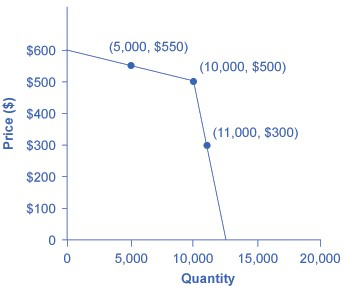Cooperation in a Kinked Demand Curve
How does Cooperation Affect the Demand Curve?
- Marketing, Advertising, Sales & PR
- Accounting, Taxation, and Reporting
- Professionalism & Career Development
-
Law, Transactions, & Risk Management
Government, Legal System, Administrative Law, & Constitutional Law Legal Disputes - Civil & Criminal Law Agency Law HR, Employment, Labor, & Discrimination Business Entities, Corporate Governance & Ownership Business Transactions, Antitrust, & Securities Law Real Estate, Personal, & Intellectual Property Commercial Law: Contract, Payments, Security Interests, & Bankruptcy Consumer Protection Insurance & Risk Management Immigration Law Environmental Protection Law Inheritance, Estates, and Trusts
- Business Management & Operations
- Economics, Finance, & Analytics
How does Cooperation Affect the Kinked Demand Curve?
Because oligopolists cannot sign a legally enforceable contract to act like a monopoly, the firms may instead keep close tabs on what other firms are producing and charging. Alternatively, oligopolists may choose to act in a way that generates pressure on each firm to stick to its agreed quantity of output.
One example of the pressure these firms can exert on one another is the kinked demand curve, in which competing oligopoly firms commit to match price cuts, but not price increases.
The reason that the firm faces a kink in its demand curve is because of how the other oligopolists react to changes in the firm’s price. If the oligopoly decides to produce more and cut its price, the other members of the cartel will immediately match any price cuts—and therefore, a lower price brings very little increase in quantity sold.
If one firm cuts its price to $300, it will be able to sell only 11,000 seats. However, if the airline seeks to raise prices, the other oligopolists will not raise their prices, and so the firm that raised prices will lose a considerable share of sales.
Thus, if oligopolists always match price cuts by other firms in the cartel, but do not match price increases, then none of the oligopolists will have a strong incentive to change prices, since the potential gains are minimal.
This strategy can work like a silent form of cooperation, in which the cartel successfully manages to hold down output, increase price, and share a monopoly level of profits even without any legally enforceable agreement.

Many real-world oligopolies, prodded by economic changes, legal and political pressures, and the egos of their top executives, go through episodes of cooperation and competition. If oligopolies could sustain cooperation with each other on output and pricing, they could earn profits as if they were a single monopoly. However, each firm in an oligopoly has an incentive to produce more and grab a bigger share of the overall market; when firms start behaving in this way, the market outcome in terms of prices and quantity can be similar to that of a highly competitive market.
Related Topics
- Market Structure
- Perfect Competition
- Bidding War
- Complements & Substitutes
- Substitution Effect
- Imperfect Competition
- Market Power
- Price Takers
- Price Makers
- Perfect Competition and Decision Making
- X-Efficiency
- Captive Market
- Contestable Market Theory
- Highest Profit Point in a Perfectly Competitive Market
- Marginal Revenue
- Using Marginal Revenue and Marginal Costs to Maximize Profit
- Marginal Revenue Curve
- Profit Margin and Average Total Cost
- Break Even Point - Cost Curve
- Shutdown Point - Cost Curve
- Short-Run Decisions Based Upon Costs in a Perfectly Competitive Market
- Marginal Costs and the Supply Curve for a Perfectively Competitive Firm
- Long-Run Average Supply (LRAS)
- Decisions to Enter or Exit a Market in the Long Run
- Long-Run Equilibrium in a Perfectly Competitive Market
- Constant, Increasing, and Decreasing Cost Industries
- Productive and Allocative Efficiency in Perfectly Competitive Markets
- Market Efficiency
- Market Inefficiency
- Pareto Efficiency
- Market Failure
- Search Theory
- Monopoly
- Natural Monopoly
- Legal Monopoly
- Bilateral Monopoly
- Promoting Innovation through Intellectual Property
- Predatory Pricing
- How Monopolists Set Price with the Demand Curve
- Total Cost and Total Revenue for a Monopolist
- Marginal Revenue and Marginal Cost for a Monopolist
- Inefficiency of Monopoly
- Perfectly Competitive Market
- Monopolistic Competition
- Duopoly
- Oligopoly
- Differentiated Products
- Perceived Demand for a Monopolistic Competitor
- Monopolistic Competitors Choose Price and Quantity
- Monopolistic Competitors and Entry
- Monopolistic Competition and Efficiency
- Cartel (Economics)
- Game Theory
- Traveler's Dilemma
- Prisoner's Dilemma
- Iterated Prisoner's Dilemma
- Nash Equilibrium
- Diner's Dilemma
- Trembling Hand Perfect Equilibrium
- Gambler's Fallacy
- Arrows Impossibility Theorem
- Backward Induction
- Tournament Theory
- Oligopoly and the Prisoner’s Dilemma
- Forcing Cooperation in a Prisoner’s Dilemma
- Cooperation and the Kinked Demand Curve
- Corporate Merger or Acquisition
- Antitrust Laws
- Herfindahl-Hirschman Index
- Concentration Ratio
- Other Approaches to Measuring Monopoly Power in an Industry
- Restrictive Practices under Antitrust Law
- Natural Monopoly
- Cost-Plus Regulation
- Price Cap Regulation
- Regulatory Capture